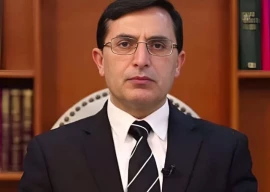
Every year, nearly 70 to 75 per cent of enrolment in medical colleges is female. However, the share of those actually practicing medicine after graduating dwindles down to between 10 and 15 per cent. A vast majority of graduating students choose not to pursue the career path due to a myriad of reasons, it has been learnt.
The enrolment rate at Rawalpindi Medical College (RMC) averages 290 students. Of these, over 60 per cent are female. The government spends a basic amount of Rs 500,000 to Rs700,000 on a student annually. This does not include the overheads of fee structures and hostel bills.
However, after investing such hefty amounts in the profession, one wonders what makes most female students quit after completing their degrees. “Most female students get admission in medical colleges on open quota,” said Rawalpindi Young Doctors Association Joint Secretary Dr Junaid Abbasi, currently serving at Holy Family Hospital, told The Express Tribune.
“The large occupancy rate of female students in medical colleges keeps men from entering the field.” This in turn incurs a heavy burden on the economy and health system, he added.
While listing the reasons behind the drop-out rate, a young female gynaecologist at Holy Family Hospital (HFH) on a condition of anonymity commented, “There are various factors. The majority women end up getting married during post-graduation and later fail to manage the profession.” She added that whereas few come just to attain a degree, others quit due to family pressures, including not being allowed to work for 36 hours straight or put in night duties.
She further cited reasons like struggling to get sanctioned posts for which many have to work for more than a year without pay while waiting for a vacancy. Furthermore, those opting for surgery or specialisation have to face tough competition from their male counterparts. The trend of females becoming gynaecologists is changing as the majority today prefer to get in to radiology or pathology. This is because these fields require fewer working hours, thus enabling women to balance their personal and professional lives more easily.
Another factor that deters female doctors from working long hours is that many hospitals do not provide proper day-care facilities. Because of this, women have to leave their children at home and end up preferring to be with them. This was stated by Professor Dr Batool Mazhar, a senior gynaecologist at Pakistan Institute of Medical Sciences. She was of the view that proper childcare facilities at government hospitals would encourage many females to continue in the profession.
According to sources, there are currently 1,170 doctors serving in the three government hospitals of Rawalpindi. This includes HFH, Benazir Bhutto Hospital (BBH) and District Headquarter Hospital (DHQ). Of these, the male to female ratios are; 140:57 in DHQ, 130:93 in BBH and 24:25 in HFH.
According to the Pakistan Medical and Dental Council, a total of 14,136 registered general practitioners including 6,300 in Islamabad and 7,836 in Rawalpindi are serving in hospitals in the twin cities. Meanwhile, there are 3,702 registered specialists including 1,726 in Islamabad and 1,976 in Rawalpindi, and 1,458 dental general practitioners, including 665 in Islamabad and 793 in Rawalpindi. There are 142 dental specialists in the twin cities, including 72 in Islamabad and 70 in Rawalpindi. The figures reflect the dearth of doctors serving in hospitals as compared to the population of the twin cities.
While talking to The Express Tribune, Dr Muhammad Haroon, a medical registrar at BBH said that when compared to the large number of patients visiting the hospital, there is indeed a shortage of doctors, especially in the emergency ward and OPDs. He added that the issue has been raised several times, but to-date no palpable progress has been made to this end.
Published in The Express Tribune, January 17th, 2012.
COMMENTS (5)
Comments are moderated and generally will be posted if they are on-topic and not abusive.
For more information, please see our Comments FAQ

















I think the availability of jobs to female should be made certain. And your article is quite helpful.! Can you please provide reference of the statistics you have given as I need it for my Law paper in LUMS. Will be highly appreciated. Thank you.
increasing the amount of post graduation training seats and proper daycare centres can improve the ratio....lacking post graduation seats,is the common problem for both male and female doctors...difference is males are forced to accept unpaid post graduate training as they have to run their homes,while females prefer to leave and sit at home in these circumstances.
medical colleges should ask them to sign a bond that guarantees at least few years of there professional practice otherwise they should not be enrolled in the college
A suggestion would be that Lady doctor have the option of Half day practice @ half the price. That should get them back in to the profession